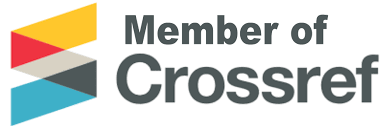DUA FAKTOR PENENTU KEBERHASILAN SEBUAH PROSES INOVASI
Abstract
This article is conducted based on a simple question: why big companies fail? Nowadays, companies are faced with market conditions that are far different compared to a few years ago. Starting from consumers who demand the speed and convenience of the products or services they will consume, until the competition becomes very tight due to the large number of newcomers emerging. Therefore, companies cannot use their old ways that might have worked in the past. Companies must be able to adapt to the current conditions by making various innovations both from the products and processes they do within the company to survive in the market of this era. However, innovation is not as simple as creating something new and different from the others. An innovation process can be said to succeed if the company can not only create a new product or process, but also can distribute the results of the innovation process so that many parties can feel the impact of their innovation. This is a qualitative research that uses comprehensive literature review to analyse the problem. The purpose of this study is to discuss two factors that have an important role in the success of an innovation process, namely creation and deployment. The output of this research is in the form of a table of operationalization of concepts that are expected to be used to help the success of the parties who will carry out an innovation process.
Â
Keywords: Innovation, Innovation Process, Creation, DeploymentKeywords
Full Text:
PDFReferences
Barney, Jay. (1991). Firm Resources and Sustained Competitive Advantage. Jurnal. Texas A&M University.
Christensen, Clayton M.. (2010). Disrupting Class, Expanded Edition: How Disruptive Innovation Will Change the Way the World Learns. New York: McGraw-Hill Education.
Detik. (2017). Ponsel Android Pertama Nokia Resmi Diluncurkan. Diunduh dari https://inet.detik.com/consumer/d-3390373/ponsel-android-pertama-nokia-resmi-diluncurkan.
Drucker, Peter F.. (2015). Innovation and Entrepreneurship. London: Taylor & Francis Ltd.
Drucker, Peter F.. (2006). Managing in Turbulent Times. New York: HarperCollins Publisher.
Free Management Books. (2018). Competitive Advantage. Diunduh dari http://www.free-management-ebooks.com/news/vrio-analysis/.
Hamel, Gary & Pralahad, C.K.. (1996). Competing for the Future. Massachusetts: Harvard Business Review Press.
Huseini, Martani & Lubis, S.B. Hari. (2009). Pengantar Teori Organisasi: Suatu Pendekatan Makro. Depok: Fakultas Ilmu Sosial dan Ilmu Politik Universitas Indonesia.
IDN Times. (2018). Ini 5 Merek Smartphone Paling Laris di Dunia, Ada Punyamu?. Diunduh dari https://www.idntimes.com/tech/gadget/jcnd/daftar-merek-smartphone-paling-laris-di-dunia-c1c2/full.
Kasali, Rhenald. (2017). Disruption. Jakarta: PT. Gramedia Pustaka Utama.
Kasali, Rhenald. (2018). The Great Shifting. Jakarta: PT. Gramedia Pustaka Utama.
Kasali, Rhenald. (2017). Tomorrow is Today. Jakarta: Mizan.
Moleong, Lexy. (2006). Metodologi Penelitian Kualitatif. Bandung: PT. Remaja Rosdakarya.
Prasetya, Irawan. (2006). Penelitian Kualitatif dan Penelitian Kuantitatif untuk Ilmu-Ilmu Sosial. Jakarta: Departemen Ilmu Administrasi.
Scharmer, Otto C.. (2009). Theory U: Learning from the Future as It Emerges. San Fransisco: Berret-Koehler.
Schilling, Melissa A. (2017). Strategic Management of Technological Innovation. New York: McGraw-Hill Education.
Sugiyono. (2009). Memahami Penelitian Kualitatif. Bandung: Alfabeta.
United Nations Development Programme. (2016). 6 ways to innovate for 2030. Diunduh dari http://www.undp.org/content/undp/en/home/blog/2016/6/16/6-ways-to-innovate-for-2030.html.
DOI: https://doi.org/10.35314/inovbiz.v7i1.911
Refbacks
- There are currently no refbacks.
Copyright (c) 2019 Adhikara Joshua Sutisna

This work is licensed under a Creative Commons Attribution-NonCommercial-ShareAlike 4.0 International License.
This Journal has been listed and indexed in :
Copyright of Jurnal Inovasi Bisnis (p-ISSN : 2338-4840, e-ISSN : 2614-6983)

Inovbiz: Jurnal Inovasi Bisnis is licensed under a Creative Commons Attribution-NonCommercial-ShareAlike 4.0 International License.
Editorial Office :
Pusat Penelitian dan Pengabdian kepada Masyarakat
 Politeknik Negeri BengkalisÂ
Jl. Bathin alam, Sungai Alam Bengkalis-Riau 28711Â
E-mail: inovbiz@polbeng.ac.id














